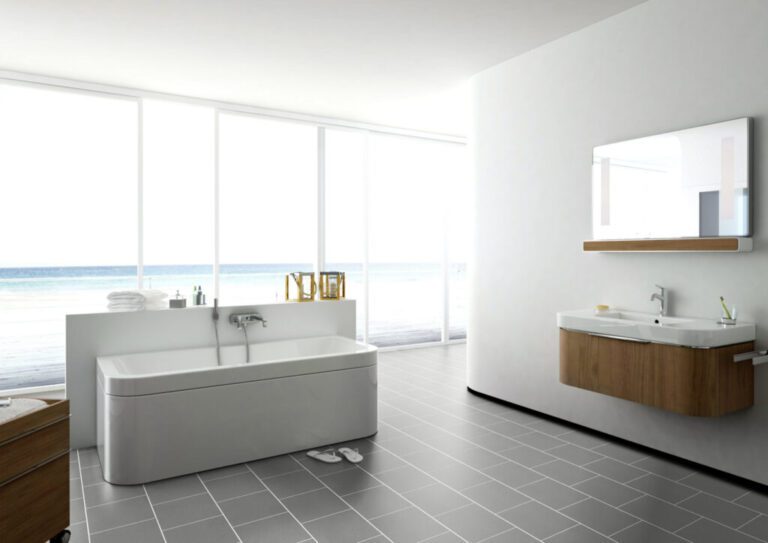Considering installing laminate flooring for underfloor heating but not sure where to start? In this comprehensive article, we explore the ins and outs of combining laminate flooring with underfloor heating.
We cover understanding the different types of underfloor heating systems, benefits, potential risks, step-by-step instructions on installation, and maintenance tips to keep your floors in top condition.
So, can you use laminate flooring with underfloor heating? Dive into this article and discover the perfect combination of comfort and style for your home!
What Is Laminate Flooring?
Laminate flooring is a synthetic flooring product made up of multiple layers, typically including a high-density fibreboard core, a photographic layer that simulates the look of wood or tile, and a protective top layer.
This layered composition gives laminate flooring its durable and versatile characteristics, making it a popular choice for homeowners seeking an affordable and low-maintenance alternative to traditional hardwood floors. The high-density fibreboard core provides stability and impact resistance, while the photographic layer allows for a variety of realistic designs to suit any decor style. The protective top layer adds scratch and moisture resistance, enhancing the longevity of the flooring.
See product: Elka 8mm V-Groove Frosted Oak
What Is Underfloor Heating?
Underfloor heating refers to a heating system installed beneath the flooring, providing warmth to the space by radiating heat upwards.
There are two main types of underfloor heating systems: electric and water-based. Electric systems consist of electric cables placed directly under the floor, while water-based systems use a network of pipes through which hot water flows.
The installation methods vary depending on the type chosen, with electric systems being easier to install than water-based ones. Benefits of underfloor heating include more efficient heat distribution, increased energy efficiency, and freedom from visible radiators that can obstruct interior design choices.
Can Laminate Flooring be Used with Underfloor Heating?
Can you have underfloor heating with laminate flooring? Laminate flooring can indeed be used with underfloor heating, providing a comfortable and energy-efficient heating solution for homes.
One of the key advantages of using laminate flooring for underfloor heating is the even distribution of heat throughout the room, eliminating cold spots and ensuring consistent warmth. The thin nature of laminate flooring allows heat to transfer efficiently, making it an excellent partner for underfloor heating systems.
This combination not only enhances the overall comfort of the living space but also helps in reducing energy consumption and heating costs.
Types of Laminate Flooring that Suitable for Underfloor Heating
When choosing laminate flooring for underfloor heating, it is essential to opt for products specifically designed to withstand the temperature changes and heat distribution associated with underfloor heating systems.
One of the key features to look for in laminate flooring over underfloor heating is thermal conductivity, which allows the heat to efficiently transfer from the heating system through the flooring to the room. Many high-quality laminate options are now available with enhanced thermal properties, ensuring optimal performance when paired with underfloor heating.
Installation requirements of laminate flooring for underfloor heating typically involve ensuring a stable subfloor, laying down a suitable underlay, and selecting the right type of laminate that can handle the heat without warping or degrading over time.
Does laminate flooring work with underfloor heating? It works. Using laminate flooring with underfloor heating extends beyond just keeping your feet warm. It can improve energy efficiency, evenly distribute heat throughout the room, and provide a comfortable living environment throughout the year. With proper installation and maintenance, laminate flooring and underfloor heating can be a winning combination for any home.
Types of Underfloor Heating That Suitable for Laminate Flooring
For laminate flooring, it is recommended to use underfloor heating systems that provide consistent and gentle heat distribution without exceeding the recommended temperature limits for laminate floors.
Underfloor heating can effectively enhance the comfort and ambience of your living space while also being energy-efficient. The gradual warmth radiating from beneath the laminate not only ensures a cosy atmosphere but also minimises heat loss.
With the right system in place, you can enjoy the luxury of warm floors without compromising the integrity of your laminate flooring. Considering factors like installation ease and maintenance requirements can help you find the perfect match for your flooring needs.
The Benefits of Using Laminate Flooring for Underfloor Heating
The combination of laminate flooring over underfloor heating offers several advantages, including energy efficiency, even heat distribution, absence of visible heating elements, and ease of installation.
Utilising laminate flooring in conjunction with underfloor heating systems can significantly reduce energy consumption, leading to cost savings over time. The even heat distribution provided by underfloor heating ensures a comfortable living environment throughout the entire room, eliminating cold spots often experienced with traditional heating systems. The absence of visible heating elements enhances the aesthetic appeal of the space, allowing for a sleek and seamless design. The ease of installation makes this combination a practical choice for both new constructions and renovations alike.
a. Energy Efficiency
Energy efficiency is a key benefit of using laminate flooring with underfloor heating, as it enables more efficient heating of the space compared to traditional heating systems.
This combination not only provides warmth and comfort underfoot but also ensures that heat is evenly distributed across the room. The thermal conductivity of laminate flooring allows for quick heat transfer, which results in a more responsive heating system. As a result, less energy is wasted, leading to greater cost-effectiveness and reduced energy consumption.
b. Even Heat Distribution
The even heat distribution provided by underfloor heating systems ensures a consistent and comfortable temperature throughout the room, enhancing the overall warmth and comfort of the space.
Uniform heat distribution is crucial, especially when paired with laminate flooring, as it prevents any temperature variations that could lead to discomfort. This consistent warmth also plays a vital role in creating a cosy ambience, perfect for chilly days.
When the heat is evenly spread across the floor, it eliminates cold spots, ensuring that every corner of the room stays pleasantly warm. This not only enhances the comfort level but also promotes energy-efficient heating, as the entire space is heated uniformly.
c. No Visible Heating Elements
One of the aesthetic advantages of using underfloor heating with laminate flooring is the absence of visible heating elements, preserving the clean and seamless look of the floors.
When heating elements are concealed beneath laminate flooring, it not only enhances the overall aesthetic appeal but also provides a sense of spaciousness and modernity to the room. By eliminating the need for unsightly radiators or heating units, this design choice allows for a more streamlined and visually appealing interior. The sleek and minimalist appearance achieved through this method creates a sense of harmony and elegance, transforming the space into a contemporary haven.
d. Easy Installation
The installation process of laminate flooring over underfloor heating is relatively straightforward, offering a convenient and hassle-free solution for homeowners.
One of the key advantages of laminate flooring is its compatibility with underfloor heating systems, making it an ideal choice for modern homes seeking efficient heating solutions.
Before beginning the installation, it’s crucial to ensure that the underfloor heating system is in good working order and compatible with laminate flooring. It’s recommended to consult the manufacturer’s guidelines to verify suitability.
Next, prepare the subfloor by ensuring it is clean, dry, and level. You may need to install a suitable underlay to provide additional insulation and support for the laminate planks.
The Potential Risks of Using Laminate Flooring for Underfloor Heating
Whilst combining laminate flooring with underfloor heating has numerous benefits, there are potential risks to consider, such as damage to the flooring, fire hazards, and challenges in temperature control.
One significant risk that arises when using laminate flooring with underfloor heating is the potential for the flooring to warp or buckle due to excessive heat exposure. This can lead to uneven surfaces, gaps, and even delamination of the laminate planks.
To mitigate this risk, it is crucial to choose laminate flooring that is specifically designed for use with underfloor heating systems. Ensuring proper installation by following manufacturer guidelines and using appropriate underlay can also help prevent damage to the flooring.
a. Damage to Laminate Flooring
Excessive heat or fluctuations in temperature can lead to damage to laminate flooring, including warping, buckling, or delamination of the floorboards.
When underfloor heating systems are not properly installed or controlled, the direct heat can cause the laminate material to expand and contract, leading to the mentioned damages. Inadequate subfloor insulation can exacerbate this effect, as the heat may not be distributed evenly, causing localised overheating. It is crucial to maintain the temperature within the manufacturer’s specified range to prevent these issues.
One effective preventative measure is to use an appropriate underlayment that provides thermal insulation and moisture protection. This will help buffer the heat and minimise the impact on the laminate flooring. Ensuring proper spacing around the edges of the room for expansion and using a floor temperature sensor to monitor and regulate the heat can safeguard your floors from long-term damage.
b. Risk of Fire
Improper installation or use of underfloor heating systems with laminate flooring may pose a fire hazard due to excessive heat build-up or electrical malfunctions.
It is crucial to follow specific guidelines when combining these two elements to ensure the safety of your home. Make sure to consult with a professional to determine the compatibility of your underfloor heating system with laminate flooring. Proper insulation and spacing are key factors to prevent overheating and potential fire risks. Regular maintenance checks and monitoring of the system can help detect any issues early on. By adhering to these safety measures, you can enjoy the comfort of underfloor heating without compromising on safety.
c. Difficulty Controlling Temperature
Maintaining precise temperature control with underfloor heating systems can be challenging, especially with laminate flooring, which may not respond quickly to temperature adjustments.
One of the key factors to consider when regulating temperature with underfloor heating and laminate flooring is the insulation underneath the flooring. Poor insulation can lead to heat loss and inefficient heating distribution, resulting in uneven temperatures and wasted energy. It’s essential to ensure proper insulation to maximise the efficiency of the system. Regular monitoring of the temperature settings and adjustments according to the external climate conditions can help in achieving consistent and comfortable indoor temperatures.
How to Install Laminate Flooring for Underfloor Heating
The installation process for laminate flooring over underfloor heating involves preparing the subfloor, laying out the underfloor heating system, installing the laminate flooring, and testing and adjusting the heating system for optimal performance.
Ensure that the subfloor is clean, dry, and level before starting the installation. This is crucial for the stability and longevity of the laminate flooring.
Next, carefully lay out the underfloor heating system following the manufacturer’s instructions, ensuring it covers the entire floor area evenly.
Regarding installing the laminate flooring, start from one corner of the room and work your way across, using spacers to maintain the expansion gap required.
After the flooring is in place, it is essential to test the heating system to ensure everything is functioning as it should. Make any necessary adjustments for maximum efficiency.
1. Prepare the Subfloor
Before laying the laminate flooring, it is crucial to prepare the subfloor by ensuring it is level, clean, and dry to create a stable base for the flooring and the underfloor heating system.
Proper subfloor preparation is essential for the successful installation of laminate flooring with underfloor heating. Moisture issues can lead to problems such as cupping, warping, and mould growth in the flooring, so it is vital to address any existing moisture concerns in the subfloor before laying the new flooring.
Subfloor levelling is key to avoiding any uneven spots that can affect the heat distribution of the underfloor heating system. A level subfloor ensures consistent heat transfer, making the heating system more efficient and effective in maintaining a comfortable indoor temperature.
b. Lay Out the Underfloor Heating System
Carefully lay out the underfloor heating system according to the manufacturer’s instructions, ensuring proper spacing and coverage to achieve uniform heat distribution beneath the laminate flooring.
Pay attention to the positioning of the heating elements to avoid any interference with the installation of the laminate flooring. It is essential to place the underfloor heating system within a well-insulated area to enhance its efficiency and prevent heat loss. Ensure that all electrical connections are securely fastened and protected to comply with safety standards. Consider consulting a professional for guidance on thermostat placement for easy access and optimal temperature control.
c. Install the Laminate Flooring
Install the laminate flooring over the underfloor heating system by following the manufacturer’s recommendations for floating floor installation, taking care to leave expansion gaps for thermal movement.
Properly preparing the subfloor is crucial before laying down the laminate flooring; ensure it is clean, level, and free of any debris. Utilise a good quality underlayment suited for use over underfloor heating to provide adequate insulation and cushioning. When selecting the laminate planks, opt for ones that are compatible with underfloor heating systems to prevent any issues with temperature fluctuations. Once the flooring is in place, adjust the underfloor heating system gradually to prevent sudden changes in temperature, which can impact the stability of the laminate.
d. Test and Adjust the Heating System
After installing the laminate flooring, test the underfloor heating system to ensure proper functionality and heat distribution, making any necessary adjustments for optimal performance.
- Turn on the underfloor heating system and allow it to run for a few hours to reach its maximum operating temperature.
- Next, check each area of the floor for consistent warmth using a handheld thermometer or thermal imaging camera.
- If there are any cold spots or uneven heating, adjust the system’s settings to balance the heat output. Ensure that the temperature control unit is functioning correctly and set at the recommended temperature for the type of flooring installed.
- It is essential to test the system in various weather conditions to assess its performance and efficiency in different circumstances.
Maintenance and Care Tips for Laminate Flooring with Underfloor Heating
To maintain laminate flooring installed over underfloor heating, regular cleaning, avoiding excessive heat exposure, and promptly addressing any issues such as moisture damage is essential for preserving the integrity and longevity of the floors.
Ensuring that the underfloor heating system is properly installed and maintained is crucial to prevent any damage to the laminate flooring.
Regular checks
on the temperature settings of the heating system can help avoid overheating that might harm the laminate. Using rugs or mats in high-traffic areas can reduce wear and tear on the flooring, while also providing extra insulation. It is also advisable to follow the manufacturer’s specific guidelines for cleaning products and methods to avoid any potential damage.
If you’re in need of top-notch laminate flooring for underfloor heating in your home, just swing by the TEKA Flooring showroom in Peterborough. We boast an extensive selection of laminate flooring, featuring diverse types and designs to suit your preferences, of course with a special discount.
If you require assistance with flooring installation at home, we also offer Fitting Services to lend you a helping hand. Don’t wait any longer – take the first step towards your dream floors. Contact us now for your personalised quote!
Read also:














